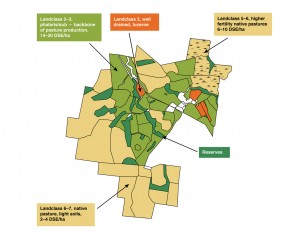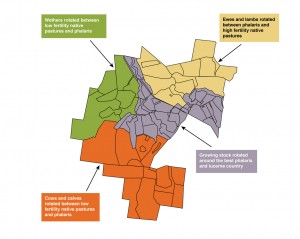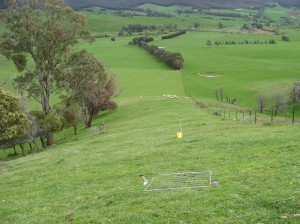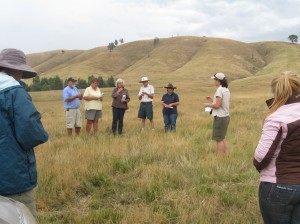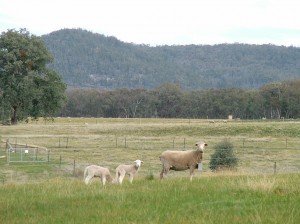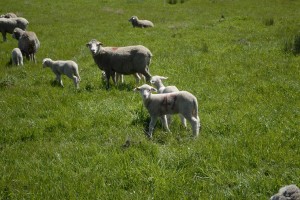Increase returns from hill country pastures
Where graziers have maximised the opportunity to improve pastures on arable parts of their land, there is an opportunity to increase profitability by increasing productivity of native pastures on non-arable hill country. On this page, we draw on EverGraze research conducted at Holbrook, Chiltern and Orange Proof Sites, together with an array of farmer case studies and Supporting Sites to discuss steps you can take for improving returns from native pastures in variable landscapes. We encourage you to follow the links to the EverGraze fact sheets, tools, research, demonstration and case study pages to obtain full details.
Understanding your landscapes
Landscapes in this region exhibit a high degree of variability. Properties will usually have a range soil types and fertility, slope, aspect and pasture species, and this has a significant bearing on production capacity and grazing behaviour across the farm. In native pastures, there is often a very large degree of variability even within a single paddock. It therefore makes sense that the first step in running a more efficient grazing system is to map the farm and identify which areas need to be managed differently, and have different production potential. A process for identifying and mapping land classes or production zones is provided in the EverGraze Action – Dividing up the farm for grazing management. Some of the key actions you can take are listed below:
- Use an aerial photograph (ideally with topography marked) to determine the size of your paddocks and differences in slope and aspect.
- Identify which pasture species are present in each area. For native pastures, the EverGraze native grass ID poster can help. Spring to summer are the easiest times of year to identify pasture species, when seed heads are present.
- In late spring, identify which areas are browning off first and which are holding green. This will indicate the relative water holding capacity and therefore growing season of each area of the farm, or just as importantly, in different areas of large paddocks.
- Conduct soil tests on different areas.
- Use the Grazing days recorder found in the EverGraze Feed Budget and Rotation Planner for one or two seasons to keep records of grazing days in each paddock and therefore determine the relative carrying capacity of each paddock. A guide to using the grazing days recorder (including YouTube video) is provided on the Setting up and managing grazing rotations page.
Production zones at Orange
An example of how soil fertility, plant available water, dry matter production and pasture composition can vary in a single paddock is provided for the Orange EverGraze Proof Site (Figure 1). At the Proof Site, three ‘production zones’ were identified. Identifying differences between the production zones provides opportunities to make more efficient management decisions. These are discussed in the sections below.
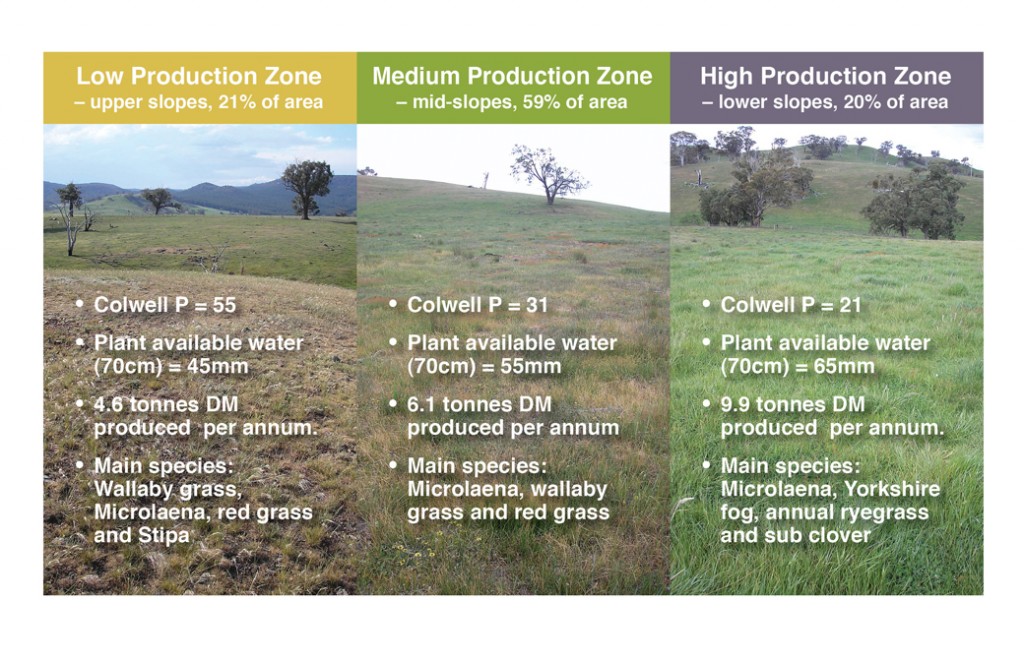
Dividing up the farm at Woomargama
Figure 2 provides an example of how a farm can be mapped according to land class and pasture types on a larger scale. In this example, Chris Mirams, Woomargama Station, Holbrook, simply classified land classes according to their production potential (carrying capacity), soil fertility (high or low) and pasture species (native, phalaris, lucerne or reserves). Chris was then able to use this classification to determine which areas to allocate to different livestock classes (Figure 3).
For further information, see the case study: Integrated system provides climate buffer – Chris Mirams, Holbrook
Options for improvement
Once you’ve identified the key characteristics of each area of the farm, you can then consider options for improved management. Some of these options are listed below.
Fence to land class
As discussed above, landscapes in this region can be extremely variable. Significant gains can therefore be made by identifying and fencing areas to be managed differently. There are many examples of EverGraze Supporting Sites and case studies across North East Victoria, Southern NSW and South West Victoria (Upper) where land class fencing has been used to increase utilisation and options for management. Figure 4 shows an example of a farm in Bonnie Doon where the north and south aspects have been divided. As a result, stock can be removed from the north face in November when it loses ground cover, while the south aspects can be grazed for the entire summer at a stocking rate of around 4 DSE/ha. The higher utilisation of the south face also helps to retain pasture quality.
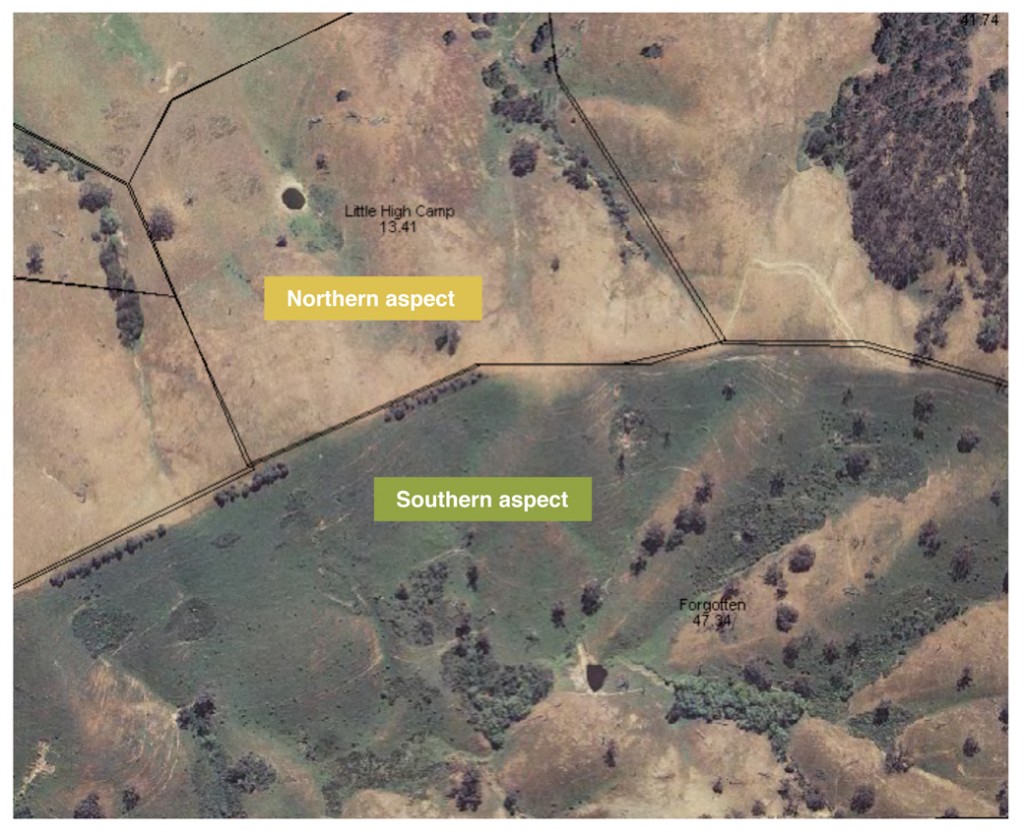
At Tallangatta Valley, the Morant’s fenced the lower slopes from the upper slopes and established a new pasture on the lower portion. The resulting stocking rate increased from 7.5 DSE/ha (in an un-fenced control), up to around 20 DSE/ha for the new pasture and 5 DSE/ha for the fenced off native pasture.
Other examples of Supporting Sites and case studies where land class fencing has increased production potential include Strath Creek (Terry Hubbard), Creightons Creek (Barry Noye), Murmungee (Judy Griffiths), Holbrook (John Keogh), and Warrak (Mark McKew).
|
|
|
Make smarter fertiliser decisions
Factors effecting return from fertiliser on native pastures
Increasing soil fertility to optimum levels is often the greatest opportunity to increase production potential through improvements in pasture composition and dry matter production. However, returns from investments in fertiliser are dependent on:
- Soil type and water holding capacity,
- Existing soil fertility levels,
- Existing pasture composition,
- Ability to utilise the extra feed grown with a high value enterprise – are stocking rates high enough?
- Ability to manage competition from the annual component to achieve persistence of the native grasses.
The existing soil fertility and pasture composition will determine the likely response to fertiliser applications. The greatest response will come from improved (sown) pastures with a legume base (such as sub clover), which are below optimum soil phosphorus, potassium and/or sulphur. These should be addressed before worrying about fertilising native pastures.
In native pastures, increased production from phosphorus fertiliser is usually reliant on the existing soil fertility levels and the presence of sub clover and nitrogen-loving annual grasses such as barley grass and annual ryegrass (see Chiltern EverGraze Proof Site key message). Sub clover will increase with increased phosphorus, and the resulting nitrogen fixation feeds both annual and perennial grasses. As well as increasing dry matter production, the higher sub clover and annual grass composition will increase feed quality and resulting animal production. However it is important to note that the increased production from annual grasses, clovers and broadleaf weeds needs to be managed to ensure the persistence of the native perennial component.
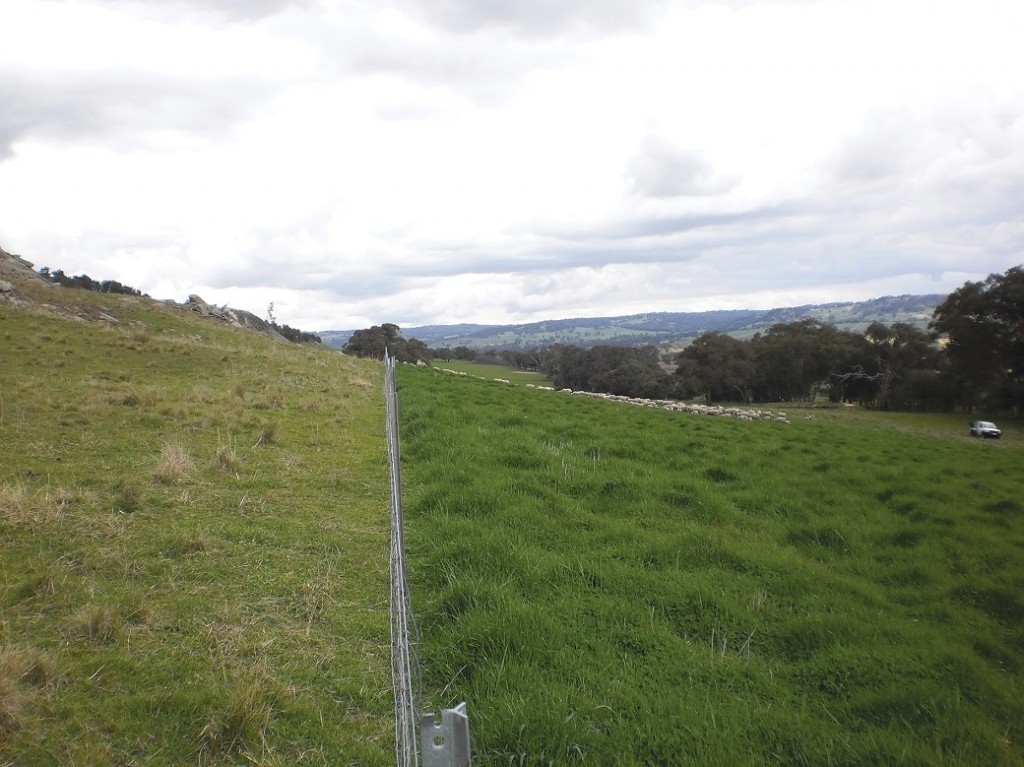
Significant cost savings from smarter applications at Orange
At the Orange Proof Site (Figure 1), the relatively high phosphorus, low dry matter production and low legume content of the Low and Medium production zones meant that the response rates from phosphorus applications on these areas was likely to be low. On the other hand, in the High production zone where phosphorus levels were below optimum and sub clover and annual ryegrass were available, the response from fertiliser applications were likely to be higher. Identifying these differences meant that during the experiment, fertiliser was only applied to 20% of the area, significantly saving on fertiliser costs.
Getting the phosphorus application rate right
Phosphorus fertiliser application rates include a maintenance component (to replace what is lost to production and fixation), and a capital component (to increase phosphorus levels). The right rate will depend on a range of factors including soil type, slope, grazing regime, rainfall and stocking rate. The following resources can assist in making decisions for your farm:
- The MLA 5 Easy Steps guide for determining phosphorus requirements.
- The Grazing Days Recorder in the EverGraze Feed Budget and Rotation Planner will determine the annual stocking rate and maintenance fertiliser requirements of each paddock.
- The Holbrook Landcare Phosphorus tool provides a simple means for calculating phosphorus requirements of each paddock.
- EverGraze quick guide for interpreting soil tests for south eastern Australia.
Investing in lime
Another consideration is whether to invest in lime. In soils that are very acid, lime can be important for preparing soils for establishing new pastures (especially phalaris or lucerne) and can increase production in some pastures by making nutrients more available (see I want to manage soil acidity). However, native pastures are inherently tolerant of high levels of soil acidity and therefore may not give an economic response to lime. This was demonstrated at the Murmungee Supporting Site where in a lime strip placed across the site. Silver grass increased dramatically while Microlaena and other species remained unchanged.

Consider which livestock will maximise returns
Decisions relating to enterprise choice and livestock systems are complex and need to account for not only the most profitable system, but also existing investments in livestock, available resources, management expertise and other associated business management changes that may be required (eg. changes to marketing), as well as your interest and passion. These factors and a process for making enterprise and livestock systems decisions is provided in the EverGraze Exchange – Livestock Systems. Below are some of the considerations based on research outcomes for setting up livestock systems which achieve higher profits from native pastures.
EverGraze reproductive sheep systems
Traditionally, livestock producers with a mix of native and improved pastures in this region have run high value reproductive stock on the improved pastures and lower value dry stock (wethers) on native country. However, EverGraze research has demonstrated that for Merino ewes with good genetics (Centre Plus lines) joined to terminal sires:
- At Chiltern, fertilised Microlaena-based native pastures with a low legume component and low base fertility achieved good conception and weaning percentages and acceptable lamb growth rates to reach store weights by December from July-born lambs. However, the quality of these pastures was not high enough to finish lambs to light trade weights after weaning, even in years with high spring rainfall.
- At Orange, fertilised Microlaena-based native pastures with a high quality annual grass (annual ryegrass) and sub clover component and high base fertility achieved good weaning percentages and good lamb growth rates for September-born lambs to reliably reach store weights and for a portion of lambs to reach light trade weights when seasonal conditions allowed.
- At Holbrook, a single flock of ewes grazed across a fertilised native pasture on hill country and a phalaris sub clover pasture on flatter country achieved high weaning percentages and acceptable lamb growth rates for July-born lambs to reach store weights by December. Under most price scenarios for lamb and wool, this system was significantly more profitable than running separate flocks of ewes and lambs on phalaris and wethers on hill country (Figure 5).
|
|
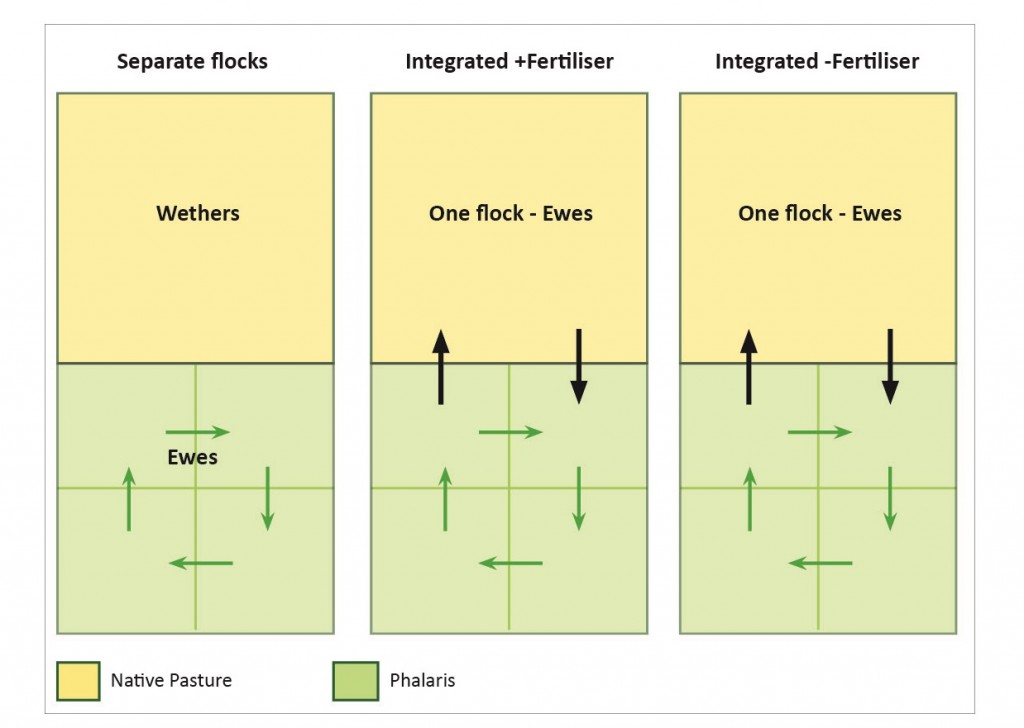
Utilising lower quality native pastures for cattle at Spring Valley
Ian Locke runs beef cattle and prime lambs on his property ‘Spring Valley’ near Holbrook. The farm is undulating with about 80% sown to productive perennials (mostly phalaris and sub clover). Native pastures make up 15% of the property, including the steep and often rocky hill country.
Previously, fertilised native pastures were set stocked with wethers for twelve months of the year, resulting in low ground cover, high levels of Patterson’s curse and poor production. In the new system, the wethers were removed and replaced by spring calving cows through winter until the last month before calving. This strategy improved the fitness of the cows and relieved the pressure from phalaris during the winter feed gap. Sheep grazed the native pastures for a short period in October to reduce the annual weed biomass, and the native pastures were then rested for the summer to allow them to seed and regenerate. The result was improved ground cover and perennial native grass composition, reduced weed burden and increased overall productivity. The stocking rates achieved on native pastures in the former wether system compared to the new strategic grazing system are presented in Figure 6. In this system, Ian discontinued fertiliser application to the native pastures which were on lighter soils than the Holbrook Proof Site and therefore less likely to respond. Removing fertiliser inputs also helped to keep weeds under control. Further details on Spring Valley can be found in the EverGraze case study.
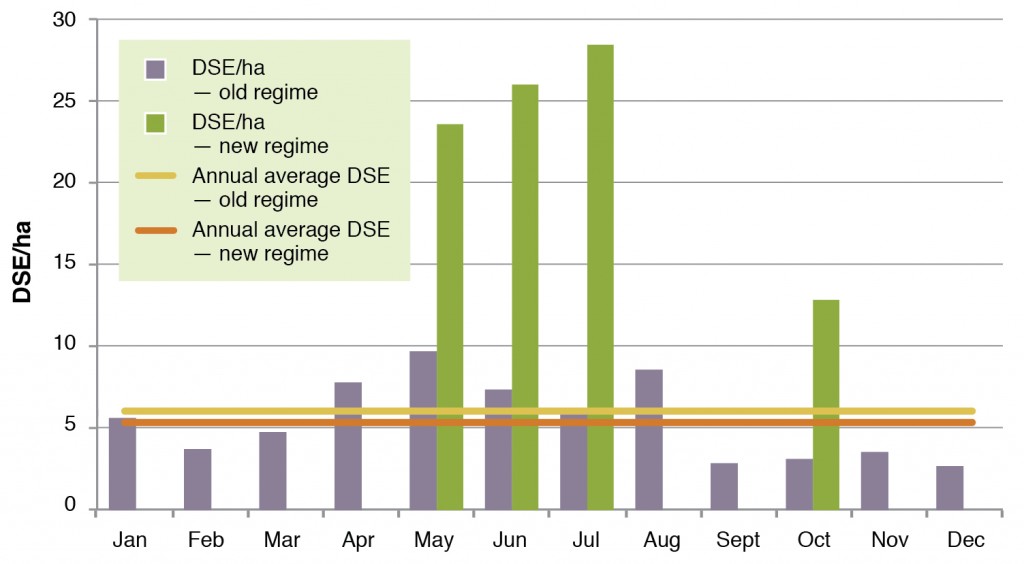
Intensify the grazing system for increased utilisation
The final consideration for increasing the efficiency of production systems in variable landscapes is to increase pasture utilisation by increasing the intensity (number of paddocks) of the grazing system.
Production benefits from intensifying the system
The Orange EverGraze Proof Site compared a 1-Paddock system to 4-Paddock and 20-Paddock rotational grazing systems (see Figure 7) and found that:
- Increasing the grazing intensity improved pasture utilisation and therefore allowed stocking rates to increase on average 8% in the 4-Paddock and 13% in the 20-Paddock system.
- A higher allowance for selective grazing in the 1-Paddock system resulted in higher lamb weaning weights (on average 12% higher than the 20-Paddock system and 4% higher than the 4-Paddock system).
- Overall lamb production per hectare was 20% higher in the 20-Paddock system and 5% higher in the 4-Paddock system compared to the 1-Paddock system.
- Average gross margins for the 20-Paddock system were $404/ha compared to $340/ha for the 4-Paddock system and $333 for the 1-Paddock system. Modelled over 40 years, average gross margins of the 20-Paddock system were $254/ha compared to $197/ha for the 1-Paddock system.
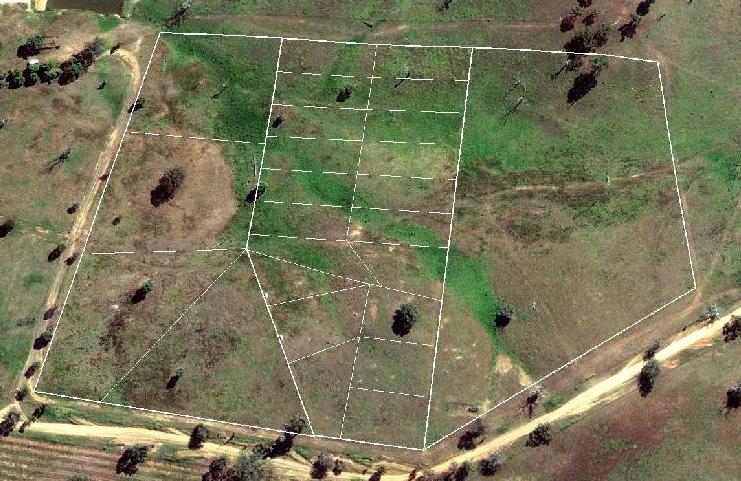
The results of the Orange EverGraze Proof Site are similar to those found for phalaris pastures in the Broadford Grazing Experiment which showed that stocking rates and wool production from wethers could be increased by around 20% by implementing a rotational grazing system. Importantly, in both studies, positive returns from implementing rotational grazing could only be achieved if stocking rate was increased in response to the higher pasture utilisation.
Return on investment from a more intensive system
Intensifying the grazing system may be as simple as mobbing up animals and rotating around existing paddocks. However, where intensifying the system requires investments in fencing and water infrastructure, production benefits need to be high enough to justify the costs. Using the results from the Orange EverGraze Proof Site experiment, a modelling study demonstrated that returns from implementing a 20-paddock rotational grazing system depended on the degree of infrastructure investment required (Table 1).
Table 1. The relationship between initial paddock number and internal rate of return when moving to a 20-paddock rotational grazing system for a typical 100ha farm on native pastures at Orange (Badgery et al. 2013).
| Investment required | Internal rate of return |
| 20 paddocks continuously grazed to 20-paddock rotation | 23.9 |
| 14 paddocks continuously grazed to 20-paddock rotation | 13.1 |
| 10 paddocks continuously grazed to 20-paddock rotation | 9.6 |
| 4 paddocks continuously grazed to 20-paddock rotation | 3.9 |
| 4 paddocks continuously grazed to 20-paddock rotation with a central watering point | 6.4 |
It should be noted that on a real farm, the benefits from fencing to land class are likely to be significantly greater than what can be achieved on experiment scale due to a much higher degree of variation in slope, aspect and pasture species composition, as was demonstrated in the Supporting Site and case study examples above.
Other benefits from more intensive systems
At the Broadford Experiment, additional benefits from rotational grazing included improved phalaris persistence, reduced broadleaf weeds, higher ground cover and reduced drought feeding costs. These benefits were not observed in the Orange experiment, or at Chiltern where both experiments were run on native pastures with a high proportion of Microlaena. It was concluded that these pastures are tolerant of set stocking, provided benchmarks for de-stocking based on feed on offer (800 kg/ha) and ground cover (80%) are in place.
Rotational grazing in action on farm
A number of EverGraze Supporting Sites and case studies in the region also provide examples of how rotational grazing can be implemented on native and/or introduced pastures. These include Warrak (Mark McKew, native pastures), Murmungee (Judy Griffiths, native pastures), Holbrook (John Keogh, phalaris), Holbrook (Chris Mirams, introduced and native pastures), Holbrook (Ian Locke, introduced and native pastures), Creightons Creek (Barry Noye, introduced and native pastures), and Tallangatta Valley (Stuart Morant, native and introduced pastures).
Further information on grazing strategies can be found in the EverGraze Exchange – Nuts and Bolts of Grazing Management.
Acknowledgements
This page has been compiled with input from scientists and farmers involved in EverGraze research at Orange, Chiltern and Holbrook Proof Sites as well as case studies and Supporting Sites in the region.
Author
Kate Sargeant, Department of Environment and Primary Industries, Benalla, Victoria
Further Information
- EverGraze Regional Package North East Vic, Southern Slopes NSW, South West Vic (Upper) – Pastures
- EverGraze Action – Dividing up the farm for grazing management
- EverGraze Exchange – Livestock systems
- EverGraze poster – Identifying native grasses
- EverGraze Feed Budget and Rotation Planner
- 5 Easy Steps for determining phosphorus requirements
- EverGraze quick guide for interpreting soil tests for south eastern Australia
- EverGraze Action – Managing native pastures in Victoria
- EverGraze Exchange – The nuts and bolts of grazing management
- Set up and manage grazing rotations
- Orange EverGraze Proof Site key message – Landscape variability can be identified, mapped and managed
- Orange EverGraze Proof Site key message – The effect of grazing intensity on production and profit from native pastures
- Chiltern EverGraze Proof Site key message – Lamb production from native pastures at Chiltern EverGraze Proof Site
- Holbrook EverGraze Proof Site key message – Integration of native and improved pasture systems increases profit
- Warrak EverGraze Supporting Site (and case study) – Managing hill country – challenges and benefits
- Creightons Creek EverGraze Supporting Site (and case study) – To rejuvenate or re-sow – weighing up the options
- Murmungee EverGraze Supporting Site – Improving productivity of Microlaena-based pastures
- Tallangatta Valley EverGraze Supporting Site (and case study) – Improving pasture productivity in hill country
- Holbrook EverGraze Supporting Site – Implementing whole farm grazing strategies in southern NSW
- EverGraze Case Study – Integrated system provides climate buffer (Chris Mirams, Holbrook)
- EverGraze Case Study – Management increases value of native pastures (Ian Locke, Holbrook)
- Strath Creek EverGraze Supporting Site – Managing steep hill country (Terry Hubbard)

